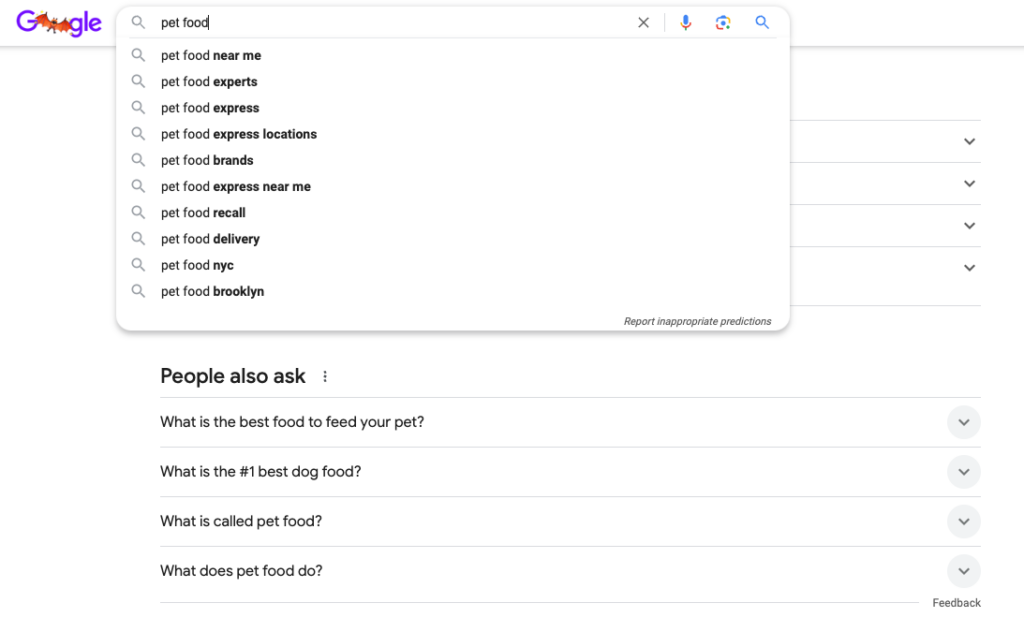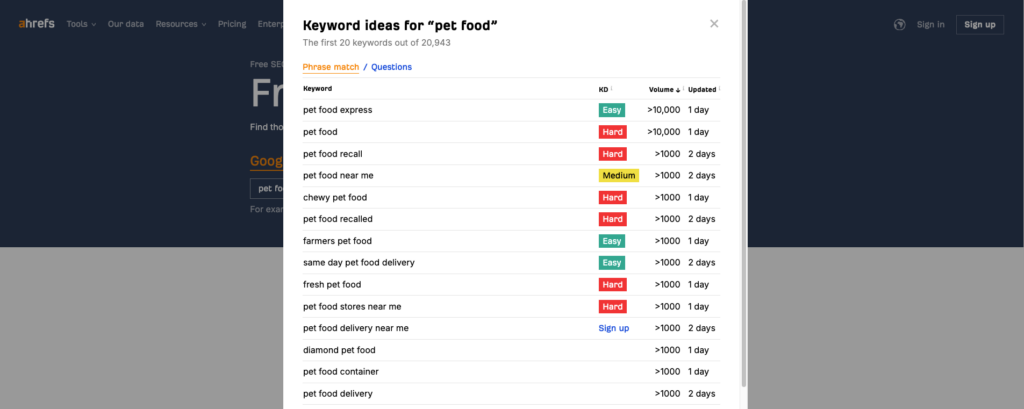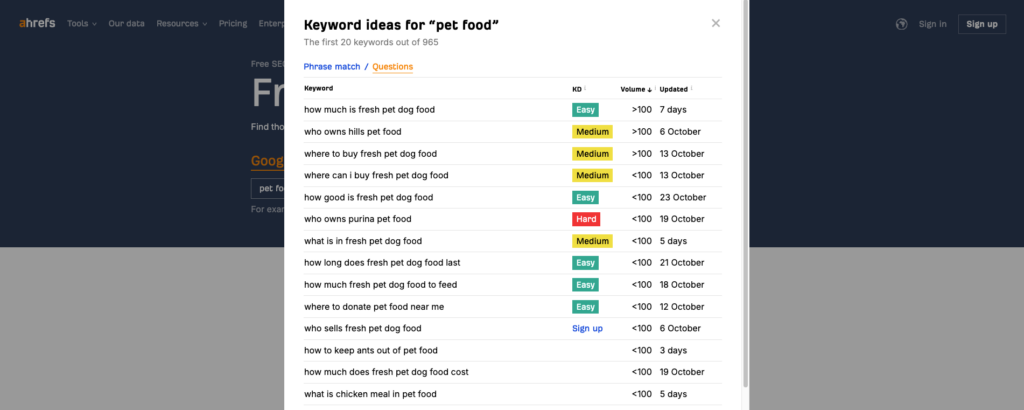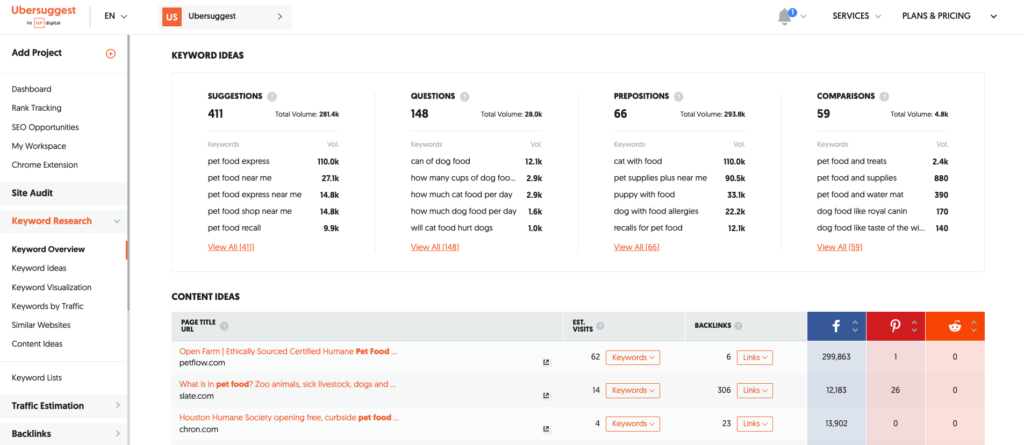How to conduct affiliate marketing keyword research for better content strategy

Becoming a successful affiliate marketer takes more than just writing blog posts and stuffing them with links. To drive consistent sales from those links, your content must align with customer expectations and your target audience. This is where affiliate marketing keyword research makes all the difference.
Whether you’re just starting out or looking to revamp your marketing approach, you’ll learn how to gather the right keywords to climb search engine rankings ‒ from choosing a niche to analyzing your competitor. We’ll also throw in proven tips to step up your content game.
What is keyword research, and why is it important for affiliate marketers
Keyword research is the process of finding the specific words and phrases people type into search engines, like Google, to find information. In affiliate marketing, these keywords help you understand what your target audience is looking for.
Using the right keywords in your content increases the chances of your blog posts appearing in search results. The higher you rank, the more visitors your website can attract.

But what’s more important than attracting visitors? Attracting the right visitors to drive sales.
Keyword research helps connect your content with users searching for it. With well-chosen keywords, you can draw in visitors with high buying intent, making it easier to convert them into customers.
Ultimately, keyword research benefits everyone involved.
Affiliate marketers gain insights into what potential customers are searching for, enabling them to create targeted content that ranks well and drives organic traffic.
The audience finds helpful, relevant information that meets their needs, making them more likely to engage with the content and click affiliate links.
Brands and merchants also win through higher conversions from well-placed affiliate promotions, increasing your affiliate marketing earnings.
How to perform keyword research for affiliate marketing
Here are the key steps to researching keywords for affiliate marketing:
- Decide on your affiliate marketing niche.
- Choose a keyword research tool.
- Define the research metrics.
- Understand search intent.
- Pick a specific type of affiliate keyword.
- Analyze your competitor.
1. Select a niche for your content
One of the biggest misconceptions in affiliate marketing is that selling anything and everything will lead to more profits. While that’s possible, it’s not recommended for the same reason a boutique wouldn’t try to sell groceries.
Each niche has a unique target audience, so focusing on one makes it easier to create relevant content that converts. Narrowing it down to a sub-niche is even better in competitive fields, as it helps you stand out and address specific needs, building stronger authority and trust.
If you don’t know where to start, explore our tutorial on the most profitable niches for affiliate marketing. You can also evaluate each niche’s market demand by exploring forums like Reddit or Quora and social media to see what people are talking about.
When researching a niche for your affiliate business, consider these factors:
- Passion. You’ll likely create content and promote products in your chosen niche for a long time, so make sure you enjoy it to stay motivated.
- Market demand. A good sign that your niche is profitable is if there are affiliate programs offering commissions for selling products in that field.
- Profit potential. Look for niches with products or services people are willing to pay for, ideally with higher-priced items or recurring commissions.
- Competition. Explore sub-niches with less competition to build momentum. For example, luxury pet accessories and eco-friendly toys are less saturated than general pet accessories.
- Longevity. While choosing a trending niche can be tempting, going with an evergreen one will keep your business relevant for the long run. Avoid betting everything on one hyped product ‒ remember how Google Glass and Google Stadia were projected to blow up but ended up flopping?
2. Get a keyword research tool
For this tutorial, we’ll use “pet food” as our seed keyword to start the keyword research process.
Manual keyword research involves a hands-on approach – you brainstorm ideas, use Google’s autocomplete, check out the People Also Ask box, and participate in forums to gauge people’s interests. It’s like detective work, gathering clues and insights to create a list of keywords from your observations.

With keyword research tools, you can speed up the research process and obtain detailed data that’s hard to find on your own, including how well keywords perform for competitors.
Here are some of the best keyword research tools to try:
- Ahrefs Keyword Generator. A free tool from the popular SEO solution Ahrefs that helps you find relevant keyword ideas based on a seed keyword.
- KeywordTool.io. This SEO tool pulls keyword suggestions from multiple platforms, including Google, YouTube, and Amazon ‒ extremely useful for targeting different platforms.
- Ubersuggest. This easy-to-use tool provides keyword ideas, search volume, competitive analysis, and insights on content ideas for each keyword.
- Moz Keyword Explorer. Besides offering essential metrics like search volume and difficulty, Moz can also analyze keywords’ organic click-through rate (CTR).
- AnswerThePublic. A keyword research tool with social listening functionality, handy for finding long-tail keywords that address user intent.
If you’re on a budget or don’t want to enter your card info for a free trial, try using Ahrefs Keyword Generator, Ubersuggest, and AnswerThePublic.
Ahrefs Keyword Generator is free to use as often as you like, while Ubersuggest and AnswerThePublic give you three searches per day when you sign up with an active email. You’ll learn how to use them in the next step.
3. Understand the metrics when researching keywords
We recommend using more than one keyword research tool because each tool can offer unique insights for the same keyword. Some tools are better for finding long-tail keywords, while others excel in revealing search intent, competition levels, or trends.
By combining insights from multiple tools and knowing which metrics to focus on, you can make informed decisions that help you choose keywords with the best potential for driving traffic and conversions.
Here are the key metrics in affiliate marketing:
Search volume
This key metric helps you gauge a keyword’s traffic potential by showing how many people are interested in a topic.
High-volume keywords attract more monthly searches, increasing the chances of clicks on your affiliate links. Since they’re often harder to rank for, try balancing them with lower-volume keywords with less competition.
Keyword difficulty
Use this metric to measure how competitive it is to rank for a term.
Highly competitive keywords often take more time and effort to rank well. Newer affiliate marketing websites ideally start with lower-difficulty keywords to gain traction faster, focusing on terms where the content is more likely to appear in search results.
For example, instead of targeting “best cat food” with a search volume of 31,000, try ranking for less popular keywords instead. “Best wet cat food” and “best cat food for indoor cats” have search volumes of 13,000 and 8,000, respectively. This means you will have less competition and better chances of ranking higher.
Organic click-through rate (CTR)
CTR indicates how likely users are to click on an organic result rather than ads or other search features.
High CTR keywords mean more potential for organic clicks, which is valuable for driving free, high-quality traffic to your content. On the other hand, low CTR keywords are often overshadowed by ads or featured snippets that draw clicks away from organic listings.
Cost per click (CPC)
CPC reflects a keyword’s commercial value, with higher CPC often signaling strong buying intent. This is especially valuable in affiliate marketing, where high CPC keywords are more likely to attract buyers, boosting the chances of conversions from affiliate links.
Search intent
This metric shows what a user hopes to find ‒ information, a product, or a comparison.
Aligning your content with search intent helps meet users’ expectations, making it more likely they’ll engage with your content. For example, “best” and “review” keywords indicate high buying intent, perfect for affiliate reviews or comparison articles that can drive sales.
Keyword trends
Keyword trends show whether a keyword’s popularity is stable, seasonal, or declining.
Jumping on trending keywords can bring in bursts of traffic and help you capture timely interest. That said, balance them with evergreen keywords to keep your traffic and long-term affiliate income consistent.
Now, let’s take a look at the three keyword research tools we recommended earlier and how they can give you insights into these metrics.
Ahrefs Keyword Generator offers keyword ideas for your target location based on the seed keyword you enter, along with each keyword’s difficulty and search volume.

It also lists long-tail keywords in question form, giving you ideas of what people are searching for related to your phrase.

This tool is perfect for quick research since you don’t need an account to use it. The downside is that search results and insights are limited without an Ahrefs subscription, which starts at $99/month.
With Ubersuggest, you can see a keyword’s search volume on both desktop and mobile, as well as its ranking difficulty for organic and paid searches and CPC. It even shows the keyword’s popularity in different locations.

You’ll also get keyword and content ideas tailored to different search intents ‒ we’ll cover this in the next step.

This tool gives more extensive insights than Ahrefs Keyword Generator. However, remember that you’re limited to three searches per day unless you upgrade ‒ paid plans start at $29/month or a one-time payment of $290.
If you want deeper insights into what people ask online, AnswerThePublic can help.
Besides offering key metrics like search volume and CPC, this tool gathers questions and phrases related to your keyword. You can view these in interactive visual formats like question clouds and comparison wheels, making it perfect for spotting relationships between queries and new trends.

To make more than three searches per day and hide unwanted sections from the visuals, you need to upgrade to Pro ‒ premium plans start at $11/month or a one-time payment of $119.
4. Understand search intent
We discussed how search intent reveals why someone searches for a specific term or phrase. Let’s explore four main types of search intent to help you create content that truly connects with your audience’s needs for better conversions:
Informational intent
Users with informational search intent want to learn more about a certain topic or have their questions answered. Search queries with this intent usually appear as a question or contain keywords like “tutorial,” “tips,” and “guide.”
Here are some examples:
- “how to store pet food”
- “what pet food do vets recommend”
- “pet food labeling guide”
You can meet this search intent by creating blog posts, guides, or tutorials that offer clear, valuable information and directly answer questions.
Navigational intent
People browsing with navigational search intent usually look for brand or website names.
These search queries belong to this type:
- “pet store near me”
- “TLC pet food login”
- “Cesar Millan pet dog training website”
Try including navigational keywords like “homepage,” “contact,” and “near me” to optimize your content for navigational intent.
Transactional intent
People with transactional search intent are ready to buy or look for purchase options, making them valuable in affiliate marketing. They’ll use keywords like “buy,” “order,” or “discount” that show they’re in a buying mood, like:
- “buy pet dog grooming kit”
- “pet dog food bulk order”
- “pet dog toys sale”
To attract these users, create product pages, include affiliate links, or add promotional content that highlights deals, discounts, or other incentives that encourage them to buy.
Commercial intent
Commercial intent can be just as profitable as transactional intent. People with this search intent usually want options and recommendations on what to buy, often using terms like “best,” “review,” or “vs.”
Take a look at these examples:
- “best pet food for senior dogs”
- “pet food brand reviews”
- “organic pet food vs regular”
Guides and reviews are the best content types to influence their decisions and encourage clicks on your affiliate links.
5. Target a specific type of affiliate keyword
Now that you recognize different types of search intent, start collecting keywords that align with your audience’s needs at each stage in the user’s journey.
By focusing on specific types of affiliate keywords, you can create affiliate marketing content that helps guide potential customers from discovery to purchase rather than just pulling in random traffic.
Here are four types of affiliate keywords to focus on in your keyword research:
General comparisons
These keywords connect with users in the research phase, where they’re exploring options before deciding. They usually have high search volumes and bring in a big audience, which also means they’re highly competitive.
For example:
- “best pet food for kittens”
- “top organic dog food brands”
- “healthiest pet food brands”
Branded comparisons
Branded comparison keywords attract users who are closer to making a decision between specific products or brands. Search volumes for these keywords are moderate because they usually contain specific brand names, like:
- “Blue Buffalo vs Royal Canin dog food”
- “Purina vs Wellness cat food”
- “Royal Canin vs Natural Balance ingredients”
Product reviews
This affiliate keyword type targets users who are close to buying and want a final opinion or validation about a specific product. As the name suggests, keywords in this category often contain phrases like “reviews” and “pros and cons”, like:
- “Royal Canin dog food review”
- “Purina Pro Plan dog food pros and cons”
- “is Wellness dry cat food good”
Even though they have lower search volumes, these keywords draw in users ready to buy, making them great for driving conversions.
Trust and authority
These keywords engage users looking for validation or a trusted opinion on a product or brand. They help establish your site as a credible source and build trust with readers, making it more likely they’ll consider your recommendations when they’re ready to buy.
Here are a few examples:
- “how to store pet food”
- “can pet food bags be recycled”
- “will pet food be affected by the port strike”
6. Analyze your competitor
As the saying goes, “A smart person learns from their own mistakes, a wise person learns from others” ‒ and this definitely applies to affiliate marketing.
Inspecting competitors’ keywords is a great way to spot gaps and opportunities in your own affiliate strategy. You might find topics they haven’t covered in depth or profitable keywords they’ve overlooked, which you can target to bring in more traffic.
Follow these steps to analyze competitors’ keywords and content:
- Identify your top competitors. These can be websites that rank well for the keywords you’re targeting or other affiliate sites in your niche. A simple Google search should help you find them easily.
- Analyze competitors’ keywords. Use tools like Google Trends or Ubersuggest to check the high-traffic keywords your competitors are ranking for. Focus on keywords with moderate search volume since they’re less competitive, giving you a chance to rank alongside them or even outrank them.
- Evaluate competitors’ content. Look at the types of content your competitors are producing around these keywords. Are they writing product reviews, blog posts, or comparison guides? Pay attention to the structure, length, and depth as well.
- Identify content gaps. Find topics or angles your competitors haven’t covered. Use AnswerThePublic or Google’s “People Also Ask” section to explore related queries that competitors haven’t addressed, allowing you to fill those gaps with your own perspective.
- Study their backlinks. Use tools like Ahrefs or Semrush to see where competitors’ backlinks come from and find similar sites to reach out to for coverage. Adding credible backlinks to your affiliate content establishes your site as a reliable source ‒ leading to higher rankings, more traffic, and stronger user trust.
- Monitor your competitors regularly. Their keyword rankings and content will likely change over time, so it’s important to keep an eye on their strategies and adjust as needed.
Tips for creating content around researched keywords
After researching and compiling potential affiliate marketing keywords, use them to create high-quality content for your website.
Here are some tips to help you start strong:
- Organize keywords by intent and content type. This will help you decide on the best content type for each keyword. For example, informational keywords are ideal for guides or tutorials, and commercial and transactional keywords work best for product reviews or comparisons.
- Include primary keywords in the intro. Naturally place your main keyword ‒ the one that represents the core topic ‒ within the first 100–150 words. This helps readers and search engines understand that the content aligns with their query.
- Distribute keywords naturally. Place primary keywords in titles, headers, and the first few sentences. Then, use related keywords that match the search intent in subheadings, body text, and image alt tags to boost your SEO.
- Answer specific questions. Make long-tail keywords into question titles within your content to answer user queries directly and improve your chances of ranking.
- Embrace related keywords and synonyms. Incorporate variations of your primary keywords to broaden targeting without sounding repetitive. For example, if your primary keyword is “best cat food,” you can also use “top wet cat food” or “recommended cat food brand.”
Expert Tip
It can be tempting to go after high-volume, generic keywords, but the competition on those can make it tough to rank well. Instead, try mixing in some related or secondary keywords throughout your content. This way, you’ll have a better shot at ranking for multiple keywords, which can bring in more traffic.
Once published, monitor keyword performance with tools like Google Analytics and Google Search Console. If some keywords aren’t driving traffic, consider re-optimizing with related keywords or updating based on trends and user behavior.
Remember to refresh your content regularly to stay relevant. New products or pricing changes may impact recommendations, so periodic updates guarantee readers get the latest accurate information.
If you want to speed up your content production flow, consider switching to Hostinger’s managed WordPress hosting. Users on Business or any of the Cloud hosting plans ‒ starting at ₱169.00/month ‒ get access to our AI features, including AI Content Creator.
Create content with relevant illustrations based on your descriptions straight from your WordPress admin dashboard ‒ ideal for generating consistent content and simplifying audits.

Browse our list of top AI content generators for more options.
Conclusion
Keyword research requires time and effort and is an ongoing process that you should regularly revisit to identify opportunities for improvement. When done right, it can take your site’s search engine visibility and conversion rates to another level, so it’s definitely worth it.
Let’s review the steps for conducting keyword research in affiliate marketing one more time:
- Pick a niche you’re passionate about.
- Choose a keyword research tool that fits your needs and budget.
- Learn key metrics to evaluate keyword potential.
- Understand search intent.
- Focus on a specific affiliate keyword type.
- Monitor your competitors’ keyword strategy.
Even when you manage to rank first for multiple keywords, always look for opportunities to fine-tune your SEO efforts to maintain your top position in search engine rankings.
We hope you find this article useful in making your research effort more effective. Drop us a comment if you have any questions or additional tips to share. Happy keyword hunting!
Affiliate marketing keyword research
How do I find good keywords for affiliate marketing?
To find profitable keywords for affiliate marketing, define your niche and use a keyword research tool to gather insights based on your chosen metrics. Once you compile potential keywords, make sure they align with search intent and your marketing goals. Analyze competitors to identify gaps and opportunities for high-converting affiliate keywords you might have missed.
How do you start keyword research?
A good rule of thumb for successful keyword research is understanding your niche and the target audience’s search intent. After identifying your audience’s needs, brainstorm seed keywords ‒ basic terms or phrases related to your niche ‒ to get an idea of where to begin.
What is an example of keyword research in affiliate marketing?
Let’s say you make an affiliate site promoting fitness supplements. Start with seed keywords like “protein powder” and “pre-workout supplement.” Use keyword research tools like Ahrefs or AnswerThePublic to find targeted affiliate keywords like “top pre-workout for beginners.” Focus on keywords with moderate search volume and low competition, then create content around them to attract visitors who are ready to purchase.



